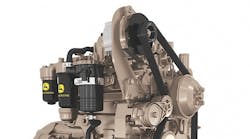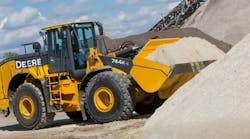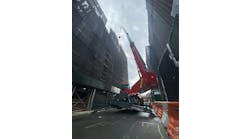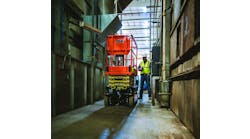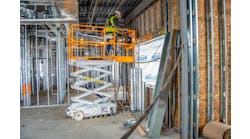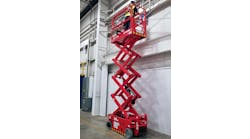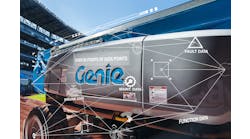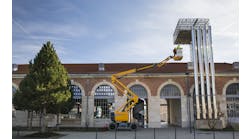Interview with John Deere Power Systems: Total Fluid Efficiency
RER’s Michael Roth spoke with John Deere Power Systems’ manager of worldwide marketing Darrin Treptow about the reactions to Tier 4 in the marketplace, along with JDPS’ developments in telematics, hybridization, more efficient after-treatment technologies, improved combustion designs and drivetrain integration.
Treptow: With John Deere Tier 4 engines, customers are experiencing more-responsive vehicle performance and improved machine productivity. End-users are also benefiting from Tier 4 solutions through lower operating costs and increased uptime.
John Deere Final Tier 4 engines will continue to provide the same or higher levels of power density and torque along with transient response that meets or exceeds that offered with our Interim Tier 4 engines.
The lower cost of operation is the result of improved total fluid efficiency. John Deere Interim Tier 4 engines have been tested in many applications around the world and established the benchmark for total fluid efficiency. Depending on the engine model and application, John Deere Final Tier 4 engines with selective catalytic reduction will see a 1 to 4 percent reduction in diesel fuel consumption while consuming a very low 1 to 3 percent of diesel exhaust fluid compared to diesel fuel consumption. The total diesel fuel and DEF consumption with our Final Tier 4 engines is generally expected to be lower than the diesel-fuel-only consumption of our Interim Tier 4 engines.
At John Deere, we have ensured a reliable Final Tier 4 solution through more than 60 million Interim Tier 4 customer hours and more than 500,000 hours of Final Tier 4 lab, field and customer testing.
Compared to previous transitions between tiers, the move to new Interim Tier 4 and Final Tier 4 engine platforms has been more gradual. Off-highway OEMs are maximizing the use of the Environmental Protection Agency’s Equipment Flexibility and Emergency Stationary provisions. The Equipment Flexibility provision is intended to ease the transition by allowing OEMs to sell a limited number of machines utilizing previous-tier engines, while the Emergency Stationary provision allows emergency stationary applications to use previous-tier products that do not require after-treatment. As more OEMs transition to Tier 4 platforms, more end users will experience the benefits of these solutions.
What will be some of the points of emphasis from this point on in terms of engine development?
John Deere continually investigates all pertinent technology improvements that can impact critical factors such as durability, reliability, engine performance, emissions, operating cost and total engine system cost. Hybridization, more efficient after-treatment technologies, improved combustion designs and drivetrain integration all represent areas where future improvements could occur.
What will be the next major trends in the engine industry overall as it pertains to construction equipment?
Telematics systems continue to gain traction in heavy equipment-based industries, and John Deere is a leader in the development of innovative management solutions including telematics. The company offers exclusive John Deere WorkSight, John Deere FarmSight and John Deere ForestSight technology suites to help construction, agriculture and forestry customers turn data into fleet management and maintenance answers. Earlier this year, John Deere Power Systems introduced John Deere PowerSight, which is a corresponding solution for John Deere off-highway diesel engines installed in OEM equipment.
John Deere PowerSight is another John Deere Power Systems solution that provides reliable uptime and low cost of operation in off-highway applications. The solution features four John Deere technologies — the JDLink machine monitoring system, machine health prognostics, remote diagnostics and programming, and the PowerAssist app — that integrate seamlessly to help customers manage their John Deere-powered OEM equipment. The technology solution is available for John Deere Final Tier 4/Stage IV, Interim Tier 4/Stage III B and Tier 3/Stage III A engines.
Using the suite of services in John Deere PowerSight, end users can achieve more uptime, increased profitability and greater productivity. For our OEM partners, John Deere PowerSight represents an opportunity to differentiate their equipment offerings. We’re pleased to offer a powerful technology solution that enhances our world-class engine lineup in OEM applications.
What trends do you see overall in the rental industry?
Rental companies value engine technology solutions with minimized complexity. However, these customers must consider that air quality districts and non-attainment regions require the best available control technology (BACT) for emissions. BACT includes the use of an exhaust filter to reduce particulate matter. So, while they may prefer to minimize the complexity of technology in their products, rental companies continue to understand that certain job sites require the utilization of machines with BACT.
We are also seeing growing interest in telematics solutions such as John Deere PowerSight as rental companies look to use data to achieve more uptime, increased profitability and greater productivity from their fleets.
